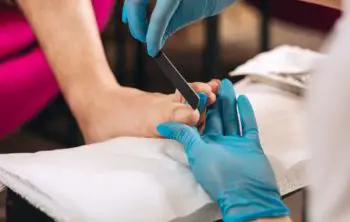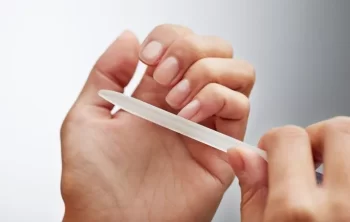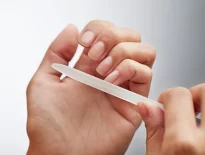If you notice your nails are yellow and you regularly wear dark nail polish, it could be that the staining from the polish is causing the yellow color. This is usually not a cause for concern and can be resolved by taking a break from nail polish and using a nail polish remover to remove any remaining color.
However, yellow nails can also be caused by underlying health issues, such as a fungal infection or psoriasis. If you have yellow nails and are unsure of the cause, it is a good idea to see a dermatologist or a doctor for an evaluation. They can determine the cause of the yellowing and recommend appropriate treatment.
It is important to take care of your nails and address any yellowing to ensure they are healthy and looking their best. One way to do this is by occasionally taking a break from nail polish and giving your nails some time to breathe. This can help prevent staining and allow your nails to recover from any damage caused by polish. If you do decide to wear polish, choose a non-toxic brand and be sure to remove it properly to avoid further staining.
Yellow Nails: Causes and Treatment Options
1. The Role ofNail Polish in Yellow Nails
One potential cause of yellow nails is the use of nail polish. The pigments in darker polishes, such as red or black, can sometimes react with the keratin protein in the nails and cause them to become yellow. This reaction can be unpredictable and may take a few days or weeks to occur. Formaldehyde, a common ingredient in nail polish, can also contribute to yellowing by causing the nails to become brittle and discolored.
To prevent yellowing caused by nail polish, it is important to use a clear base coat before applying color. This can help protect the nails and prevent staining. It is also important to give your nails a break from polish every now and then to allow them to “breathe” and recover from any damage. Using a base coat can also help extend the life of your manicure and prevent the polish from chipping or peeling.
In addition to using a base coat, you can also try using non-toxic nail polish brands, which are formulated without potentially harmful ingredients like formaldehyde. This can help reduce the risk of yellowing and other negative effects on the nails.
Overall, yellow nails caused by nail polish are usually not a cause for concern, but if you are concerned about the health of your nails, it is always a good idea to see a dermatologist or a doctor for an evaluation. They can help determine the cause of the yellowing and recommend appropriate treatment.
2. Using An Acetone-Based Nail Polish Remover
Using an acetone-based nail polish remover can contribute to yellowing of the nails. This is because acetone is a strong solvent that can strip the nails of their natural oils, causing them to become dry and brittle. When the nails are dry and damaged, they are more prone to staining and discoloration.
It is always recommended to use a non-acetone nail polish remover, especially if you have dry or brittle nails. Non-acetone removers are typically gentler on the nails and can help prevent dryness and damage. They are also less likely to cause yellowing.
If you do need to use an acetone remover, be sure to follow up with a moisturizing nail treatment to help restore moisture to the nails. This can help prevent further dryness and damage, and can also help improve the overall health and appearance of your nails.
Overall, it is important to be mindful of the products you use on your nails and to choose options that are gentle and nourishing. By taking care of your nails and using products that are kind to them, you can help prevent yellowing and other issues that can affect their health and appearance.
3. Tar And Nicotine From Cigarettes
Tar and nicotine from cigarettes can also cause yellowing of the nails. These substances can accumulate on the nails over time and cause them to become yellow and discolored. In addition to causing yellowing, smoking can also have other negative effects on the nails, such as making them dry and brittle.
If you are a smoker and are concerned about yellowing of your nails, one of the best things you can do is to quit smoking. This can help prevent further staining and damage to the nails, and can also have numerous other health benefits.
If you are unable to quit smoking or are looking for ways to address yellowing caused by smoking, there are a few things you can try. One option is to use a nail polish remover or other product specifically formulated to remove nicotine stains from the nails. You can also try using a moisturizing nail treatment to help restore moisture to the nails and improve their overall health and appearance.
Overall, it is important to be aware of the impact that smoking can have on the health and appearance of your nails, and to take steps to prevent or address any issues that may arise.
4. Fungal Infection
Fungal infections are another common cause of yellow nails. These infections can affect the nails in a variety of ways, including causing them to become yellow, thick, flaky, and crumbly. Fungal infections can also cause an unpleasant smell and may cause the nail bed to retract, leading to further nail damage.
If you think you may have a fungal infection, it is important to see a doctor for proper diagnosis and treatment. Prescription medications are usually more effective at treating fungal infections than home remedies, and it is important to get appropriate treatment to prevent the infection from worsening.
Yellowing of the nails can also be a sign of other underlying health issues, such as thyroid, liver, or lung diseases, diabetes, psoriasis, or nutritional deficiencies like low iron or zinc. If you are concerned about the cause of your yellow nails, it is a good idea to see a doctor for an evaluation. They can help determine the cause and recommend appropriate treatment.
Overall, it is important to pay attention to the health and appearance of your nails and to seek medical attention if you notice any changes that may be cause for concern.
5. Eating Certain Foods
Eating certain foods can also contribute to yellowing of the nails. This is because some foods, particularly those that contain spices like turmeric, can stain the nails and cause them to become yellow. This is more likely to happen with lighter-colored nail polish, as it is less able to resist staining.
If you handle food with your fingers frequently and are concerned about yellowing of the nails, there are a few things you can try to prevent staining. One option is to use acetone-free nail wipes or acetone-free nail polish remover to help remove any stains from the nails. You can also try wearing gloves while handling food to help prevent staining, or you can choose to use darker-colored nail polish, which is less prone to staining.
Overall, it is important to be mindful of the impact that certain foods and activities can have on the nails, and to take steps to prevent or address any staining or discoloration that may occur. By taking care of your nails and protecting them from potential sources of staining, you can help keep them looking healthy and attractive.
Do You Have To Be Concerned?
In general, yellow nails are not a cause for concern and can usually be resolved with simple home remedies or by making a few lifestyle changes. If you have yellow nails and are unsure of the cause, it is a good idea to see a dermatologist or a doctor for an evaluation. They can help determine the cause and recommend appropriate treatment.
There are a number of ways to address yellowing of the nails, depending on the cause. If your yellow nails are caused by nail polish staining, you can try using a nail polish remover or other product specifically designed to remove stains. You can also try giving your nails a break from polish and using a base coat to help prevent staining in the future.
If your yellow nails are caused by a fungal infection, you will need to see a doctor for a prescription medication. It is important to get appropriate treatment for a fungal infection to prevent it from worsening.
If your yellow nails are caused by smoking or other factors, there are a few home remedies you can try. One option is to use a lemon juice and baking soda mixture to help remove stains from the nails. You can also try using a moisturizing nail treatment to help improve the health and appearance of your nails.
Overall, it is important to take care of your nails and address any issues that may arise to ensure they are healthy and looking their best. By following a few simple steps, you can help prevent yellowing and other problems that can affect the health and appearance of your nails.
1. Hydrogen Peroxide and baking soda
Hydrogen peroxide and baking soda can be a effective way to remove stains from the nails and help restore their natural color. To use this method, mix together equal parts hydrogen peroxide and baking soda to form a paste. You can also use water in place of baking soda if desired.
To apply the paste, use a cotton swab or an old toothbrush to coat the nails with the mixture. Leave the paste on for about 5 minutes, then rinse it off with warm water. Be sure to rinse your nails well and follow up with a moisturizing hand cream or cuticle oil to help prevent dryness and damage.
It is important to be careful when using hydrogen peroxide, as it can be drying to the nails and skin. Be sure to use it in a well-ventilated area and avoid getting it in your eyes or mouth. If you have sensitive skin or are concerned about any potential side effects, it is a good idea to test the mixture on a small patch of skin before applying it to your nails.
2. Denture Tablets
Denture tablets can also be an effective way to remove stains from the nails and restore their natural color. These tablets contain ingredients like sodium bicarbonate and citric acid, which can help cut through stains on hard surfaces like teeth and nails.
To use this method, dissolve 2-4 denture tablets in a small bowl of water and soak your nails in the mixture for about 10-15 minutes. Then, pat your nails dry and follow up with a moisturizing hand cream or cuticle oil to help prevent dryness and damage.
It is important to follow the package directions when using denture tablets and to be mindful of any potential side effects. Some people may have sensitive skin or allergies to certain ingredients in the tablets, so it is a good idea to test the solution on a small patch of skin before applying it to your nails.
3. Whitening Toothpaste
Whitening toothpaste can also be used to remove immediate stains from the nails. This is because toothpaste contains abrasive ingredients like baking soda, which can help scrub away stains and discoloration.
To use this method, apply a small amount of whitening toothpaste to each nail and rub it in. Let the toothpaste sit on the nails for a few minutes, then rinse it off with water.
It is important to note that this method is not intended for long-term stains or for use on severely discolored nails. If you have persistent yellowing or other issues with your nails, it is a good idea to see a dermatologist or a doctor for an evaluation and proper treatment.
4. Lemon Juice
Lemon juice can be an effective natural remedy for yellowing of the nails. This is because lemon juice contains citric acid, which can help remove stains and brighten the nails.
To use this method, you can either apply lemon juice directly to the nails with a cotton ball or soak your nails in a bowl of lemon juice for about 10-15 minutes. You can also slice a lemon in half and work each nail into it for 30-60 seconds to help remove stains.
It is important to be mindful of the acidity of lemon juice and to follow up with a moisturizing hand cream or cuticle oil to help prevent dryness and damage. You may need to repeat this treatment daily until you are happy with the results.
5. Buffing
Buffing your nails can also help remove yellow stains and improve the overall appearance of your nails. By buffing the surface of the nails, you can remove the top layers where the stains are located, helping to restore their natural color.
It is important to be careful when buffing your nails, as buffing too deeply can weaken the nails or make them vulnerable to infection. Buffing too deeply can also cause the nails to split or peel, which can lead to further damage. Instead, focus on buffing the surface of the nails gently, using a light touch to remove any stains or discoloration.
If you choose to buff your nails, it is a good idea to follow up with a clear strengthening polish to help protect the nails and improve their overall health. This can help prevent further staining or damage and can help keep your nails looking healthy and attractive.
6. Dark Nail Polish
One of the simplest ways to prevent yellowing of the nails is to avoid using too much dark nail polish. Dark nail polishes, particularly those with high levels of pigment, can be more prone to staining the nails and causing them to become yellow or discolored.
To help prevent this from happening, try to limit your use of dark nail polish or switch to lighter-colored shades. This can help give your nails a break from the staining agents in dark polishes and allow them to recover.
It is also a good idea to use a base coat when applying nail polish, as this can help protect the nails from staining and improve the overall health of your manicure. By taking these simple steps, you can help prevent yellowing of the nails and keep them looking healthy and attractive.
In Conclusion
In conclusion, yellow nails can be caused by a variety of factors, including the use of dark nail polish, fungal infections, and smoking. While yellow nails are not typically a cause for concern, they can be unsightly and many people prefer to have healthy, stain-free nails.
There are several ways to address yellowing of the nails, including using nail polish removers or other products specifically designed to remove stains, soaking the nails in lemon juice or other solutions, and buffing the surface of the nails. It is important to be careful when using these methods and to follow up with a moisturizing hand cream or cuticle oil to help prevent dryness and damage.
To help prevent yellowing of the nails in the future, try to avoid using dark nail polish, use a base coat to protect the nails, and take regular breaks from polish to allow the nails to recover. If you are concerned about the health or appearance of your nails, it is a good idea to see a dermatologist or a doctor for an evaluation and appropriate treatment.






